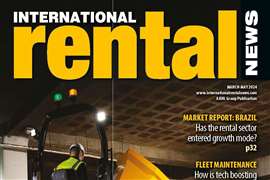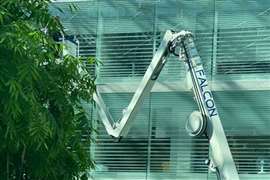Flexibility to the max
10 February 2014

As with just about every construction equipment sector, it is engines that are driving the development, or rather the lack of it, where demo specification standard and high reach machines are concerned. To be more accurate, it is the latest round of emission regulations that are responsible for the relative quiet that has emanated from the main equipment manufacturers over recent months.
Compliance with Stage IIIB and Tier 4 Interim regulations has resulted in a spate of large and small standard machines over the last 24 months as the OEMs ensure that they have a product range that meets the requirements of these regulations. However, lurking in the wings are the even more stringent Stage IV/Tier 4 Final requirements that will begin to come into force in Europe, North America and Japan over the course of this year and next. This is certainly concentrating the minds of the OEMs as they work on incorporating all the additional elements required for compliance in the shape of various exhaust aftertreatment systems and other additional components that need to be squeezed into already confined engine bays on their machines.
Given that the number of demo spec’d and high reach machines sold annually around the world is tiny in comparison to the volume of standard excavators – precise sales figures are not available – it is hardly surprising that manufacturers are likely to be waiting to get their Stage IV/Tier 4 Final offerings ready before beginning the development of what are firmly low volume niche products for our industry, using these models for the carrier.
IIIB exceptions
As always, there are exceptions to the rule and in this case they come from Volvo and Hitachi, respectively. Volvo launched Stage IIIB versions of its 27.4 m (90 ft) EC480DHR and the 21 m (69 ft) EC380DHR at the bauma exhibition in April 2013. The first of the larger of the two machines was officially handed over to Finnish customer Delete at the show, with its first outing in Helsinki being the subject of a site report in this magazine (see D&Ri, Sept-Oct 2013, p19).
Hitachi’s IIIB machine starred in another site report in the same issue where the first ZX470-5LCH in Germany was working on a residential redevelopment in Munich in the hands of German contactor B Trinkl (see page 16). Stage IIIB compliance is a necessity for machines working in that city, hence the reason for Trinkl’s acquisition of this latest generation Hitachi. The ZX470 high reach has a pin height of 25 m (82 ft) with a 2.5 tonne tool maximum.
It is reasonable to suppose that when the next engine evolution is achieved and OEMs have carriers available with Stage IV/Tier 4 Final compliance, development work will start on the next generation of demolition specification standard machines and their high reach variants. D&Ri will be there to report.
It is those companies that carry out the modification of standard machines to meet specific customer requirements that are currently making the headlines. One dominant trend is emerging in their efforts and this is ‘carrier flexibility’. Carrying out the necessary modifications to a new standard carrier to suit the demanding demolition function turns the machine into a premium product, with an attendant hefty purchase price, and end users are therefore naturally eager to get the maximum usage out of any machine that is possible.
When high reach excavators first emerged from modifiers and OEMs alike, they were dedicated machines that could only be used in that role. Over time, coupling systems were developed to allow them to be used in both high reach and standard boom configurations, with change-over times coming down over the years to, in some cases, less than half an hour on today’s modern machines.
The last two years have seen this need for flexibility addressed even further by the development of new concepts to the point where a single carrier can be supplied with a range of front ends that allow it to be used across a number of different applications in addition to the demolition and standard dig applications. One company at the forefront of this is the UK’s Kocurek Excavators, based in Ipswich. In 2013, working together with UK demolition contractor Armac, who was the driver behind the project, it developed what is now known as the ABC concept. This consists of a single carrier than can be equipped with three different front ends that provide variable working heights and tool sizes in addition to a standard dig boom. This allows the machine to be tailored to the application, but more importantly, only the single carrier is required for four potential applications if all boom configurations are available.
Multi carriers
And the flexibility concept is being taken a massive step further by Kocurek working in partnership with German Hitachi dealer Kiesel. The result is a single carrier, in the first instance a Hitachi ZX470LC, that is able to carry an even wider range of booms for a variety of different applications for German customer AWR. It is the first in what will be known as the KMC470-BTV range. KMC is the acronym for Kiesel Multi Carrier, with the B standing for the OilQuick boom connect system, T for the Tritech three cylinder quattro valve lift system and V for variable undercarriage. The idea is that every 470 produced will have the same stub boom with the OilQuick and three lift cylinders. The three cylinders provides the necessary power when in demolition mode but when in standard mode, the Quattro speed valve takes away some of the power and allows the machine to work at the same speed. Many of Kocurek’s modified machines feature larger cylinders to provide the power in demolition mode but which mean that the machine operates more slowly when in standard mode.
Kiesel and Kocurek are currently developing a range of front ends for the carrier – a standard backhoe arm, a two piece stub boom with a standard dipper, a two piece with a heavy duty dipper to carry a heavier tool, a 18 m (59 ft) two stage high reach, a 26 m (85.3 ft) high reach, a 30 m (98.5 ft) high reach, a 34 m (111.5 ft) telescopic high reach, an 18 m long reach, a 20 m (65.6 ft) long reach, a 22 m (72.2 ft) long reach, a 30 m tele-dipper and a material handling arm as well.
A 34 m high reach on a carrier the size of a Hitachi 470 is possible through the use of a fully extending undercarriage – both in terms of track width as well as full hydraulic extension. The OilQuick system and the three lift cylinders also add considerable additional weight to the carrier in the right places. Together, these two factors allow the use of a relatively longer arm.
In addition, work is being carried out to apply the concept to Hitachi’s ZX350 machine to turn it into the KMC350-BTV – this has a stub boom similar to that on the 470 machine that will be able to carry a standard backhoe, heavy duty two piece, two stage high reach, 21 m (69 ft) high reach, 24 m (78.8 ft) high reach, 16 m and 18 m long reach, 25 m (82 ft) tele-dipper and a material handling boom.
Initially where the 470 is concerned, because it needs a full undercarriage, boom fabrication and carrier modification will be carried out by Kocurek. The first machine will then be transported to Kiesel, who will then install the hydraulic system using the highest quality components possible since the machine will be supplied to AWR with an extended warranty.
When the second is ordered, Kocurek again will carry out the necessary carrier modifications, but Kiesel will send all the hydraulic components used on the AWR machine to Ipswich, where Kocurek will carry out all assembly and testing. It is this production route that all further KMC470 machines will follow.
With the KMC350 machines, all modifications will be undertaken at Kiesel’s own engineering facility to avoid unnecessary transport costs.
Orders have been placed for these numerous different front ends to be produced by Kocurek over the course of 2014 as stock for Kiesel, who is confident that they will be sold on the basis of enquiries that have been received to date. Kocurek reports that everything it has produced to date in Ipswich for Kiesel for stock has been sold before it has been completed. However, two KMC350 machines have already been converted, with five more base machines ordered with various front ends. Where the KMC470 is concerned, four have already been ordered for 2014, with the one currently at Kocurek the first of these. According to Kocurek, all these further orders are for delivery in the first half of the year, so the total demand for 2014 delivery is likely to be even greater,
Keeping them working
Kiesel are pushing to sell the concept outside of Germany, although this raises the issue of service and support, since the machines will be marketed and sold as KMC rather than Hitachi. However, the warranty issues with the carrier could be dealt with by the relevant national Hitachi dealer, with Kiesel supplying the service and support of the booms and associated hydraulics and OilQuick systems, perhaps through the Terex Fuchs dealer network (Kiesel is a German dealer for this brand).
Should KMC machines be sold into the UK market, the service and support would be handled by Kocurek from its Ipswich base. The experience it will gain while carrying out the installation of the various systems of the KMC470 would obviously be invaluable in this regard. However, the OilQuick system itself is not as popular in the UK as it is in Germany, in part because of its cost, and that might well impact on the acceptance of the concept. So it may be early days for the KMC concept outside of the German speaking region of Europe.
Nevertheless, it is clear that KMC and other similar concepts, such as Kocurek’s own ABC, look likely to change the face of the mid sized demolition excavator sector. Buying one modified carrier with a selection of front ends that can be used across the full spectrum of applications to be found in the sector obviously offers substantial economic benefits over the cost of three or possibly four machines that can only be used in one or two, especially when the carriers themselves are the volume end of the machines that find their way into our industry.
The only negative then could be that the volume of work encountered at any one time for a contractor might well be greater than a single machine and operator could handle, but that might not really be a bad position to be in!






